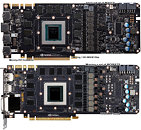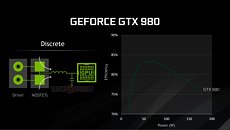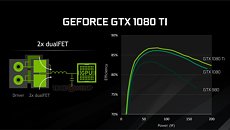- Joined
- Oct 9, 2007
- Messages
- 47,638 (7.44/day)
- Location
- Dublin, Ireland
| System Name | RBMK-1000 |
|---|---|
| Processor | AMD Ryzen 7 5700G |
| Motherboard | Gigabyte B550 AORUS Elite V2 |
| Cooling | DeepCool Gammax L240 V2 |
| Memory | 2x 16GB DDR4-3200 |
| Video Card(s) | Galax RTX 4070 Ti EX |
| Storage | Samsung 990 1TB |
| Display(s) | BenQ 1440p 60 Hz 27-inch |
| Case | Corsair Carbide 100R |
| Audio Device(s) | ASUS SupremeFX S1220A |
| Power Supply | Cooler Master MWE Gold 650W |
| Mouse | ASUS ROG Strix Impact |
| Keyboard | Gamdias Hermes E2 |
| Software | Windows 11 Pro |
Feast your eyes on the first image of a reference NVIDIA GeForce GTX 1080 Ti graphics card, compared side by side with the PCB of the company's flagship (still) TITAN X Pascal. As you can see, the GTX 1080 Ti is based on the same PCB as the TITAN X Pascal, since the two cards are based on the same "GP102" chip (albeit with different core configurations). To begin with, the GTX 1080 Ti features 11 memory chips, compared to 12 on the TITAN X Pascal, on account of its narrower 352-bit GDDR5X memory interface. It makes up for the narrower memory bus with faster 11 Gbps memory chips, than the 10 Gbps chips found on the TITAN X Pascal.
The main difference between the GTX 1080 Ti and TITAN X Pascal, however, is NVIDIA bolstering the VRM with a 2x dual-FET design. NVIDIA basically placed an additional set of MOSFETs and capacitors along all the blank traces of the reference PCB. This approach lowers the load on each individual MOSFET, in turn lowering VRM temperatures. It probably also enables a higher power-limit. NVIDIA also updated the reference design cooling solution with a new vapor-chamber base-plate. The cooler also exhausts through the entire width of the second slot in the card's I/O shield. This meant sacrificing the DVI connector. The GeForce GTX 1080 Ti goes on sale later this month, priced at US $699.




View at TechPowerUp Main Site
The main difference between the GTX 1080 Ti and TITAN X Pascal, however, is NVIDIA bolstering the VRM with a 2x dual-FET design. NVIDIA basically placed an additional set of MOSFETs and capacitors along all the blank traces of the reference PCB. This approach lowers the load on each individual MOSFET, in turn lowering VRM temperatures. It probably also enables a higher power-limit. NVIDIA also updated the reference design cooling solution with a new vapor-chamber base-plate. The cooler also exhausts through the entire width of the second slot in the card's I/O shield. This meant sacrificing the DVI connector. The GeForce GTX 1080 Ti goes on sale later this month, priced at US $699.




View at TechPowerUp Main Site
Last edited:


 EDIT: Thx. EDIT2: Nevermind.
EDIT: Thx. EDIT2: Nevermind.


